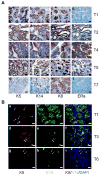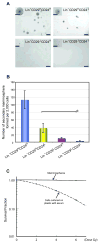Identification of tumor-initiating cells in a p53-null mouse model of breast cancer
- PMID: 18559513
- PMCID: PMC2459340
- DOI: 10.1158/0008-5472.CAN-07-6353
Identification of tumor-initiating cells in a p53-null mouse model of breast cancer
Abstract
Using a syngeneic p53-null mouse mammary gland tumor model that closely mimics human breast cancer, we have identified, by limiting dilution transplantation and in vitro mammosphere assay, a Lin(-)CD29(H)CD24(H) subpopulation of tumor-initiating cells. Upon subsequent transplantation, this subpopulation generated heterogeneous tumors that displayed properties similar to the primary tumor. Analysis of biomarkers suggests the Lin(-)CD29(H)CD24(H) subpopulation may have arisen from a bipotent mammary progenitor. Differentially expressed genes in the Lin(-)CD29(H)CD24(H) mouse mammary gland tumor-initiating cell population include those involved in DNA damage response and repair, as well as genes involved in epigenetic regulation previously shown to be critical for stem cell self-renewal. These studies provide in vitro and in vivo data that support the cancer stem cell (CSC) hypothesis. Furthermore, this p53-null mouse mammary tumor model may allow us to identify new CSC markers and to test the functional importance of these markers.
Figures





References
-
- Pardal R, Clarke MF, Morrison SJ. Applying the principles of stem-cell biology to cancer. Nat Rev Cancer. 2003;3:895–902. - PubMed
-
- Huntly BJ, Gilliland DG. Cancer biology: summing up cancer stem cells. Nature. 2005;435:1169–70. - PubMed
-
- Lapidot T, Sirard C, Vormoor J, et al. A cell initiating human acute myeloid leukaemia after transplantation into SCID mice. Nature. 1994;367:645–8. - PubMed
-
- Bonnet D, Dick JE. Human acute myeloid leukemia is organized as a hierarchy that originates from a primitive hematopoietic cell. Nat Med. 1997;3:730–7. - PubMed
-
- Hope KJ, Jin L, Dick JE. Acute myeloid leukemia originates from a hierarchy of leukemic stem cell classes that differ in self-renewal capacity. Nat Immunol. 2004;5:738–43. - PubMed
Publication types
MeSH terms
Substances
Grants and funding
LinkOut - more resources
Full Text Sources
Other Literature Sources
Molecular Biology Databases
Research Materials
Miscellaneous

